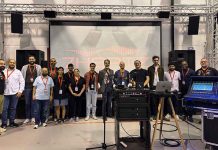What industry need does the CCL cater to, and how has the R&D process behind the product helped shape its design?
Santiago Alcalá Baillie: “Once the analysis of the exact requirements of the compact line array applications and the target system architecture and physical characteristics of CCL were defined as a passive, two-way line array element of weight and dimensions between T10 and Y Series, the challenge for the d&b R&D LS development team, led by Matthias Christner, Nico Paul and Ewen Rolland, was to achieve broadband directivity control with low-frequency cardioid behaviour, applying an entirely new acoustical principle, different to the one utilised for the SL Series.
“SL Series models, as three-way active systems, use two channels of DSP and amplification to create the frequency dependant delay of the front radiating woofers, which together with the bass reflex ports are ideally spaced apart with the rear/side radiating woofers, as in an ‘end-fire cardioid arrangement’, creating a coherent acoustical energy summation to the front and a very significant SPL reduction towards the rear of the cabinet.
“The CCL, being a passive, two-way system, uses a single amplifier and DSP channel to power the entire set of transducers, utilising a new acoustic resonator, in a new band-pass arrangement for the rear/side woofers, which creates the frequency dependant delay that allows for a ‘gradient array’ acoustical arrangement, expertly implemented with a new d&b patent. This results, once more on a broad-band reduction of the LF to the rear and sides of the cabinet and an addition of acoustic energy to the front.
“Furthermore, the d&b R&D developed an entirely new target curve for the distribution of the acoustical energy over frequency, creating a new type of HF transducer and waveguide/horn assembly design that allows for over 3dB of additional headroom above 1KHz, while minimising audible and measurable distortion compared to conventional designs.”
What features of the CCL system make it well-suited for the Middle East?
SAB: “Ever since the launch of the GSL, our customers have resonated with what we have achieved, with broadband directivity control and ArrayProcessing in particular, standing d&b apart from our competitors. It’s why our SL-Series are now the touring system of choice for the world’s top artists. However, not all applications require large-format line arrays. So, we followed with the KSL and XSL, which made massive impacts on the market. Still, people asked if we could deliver the benefits of the SL-Series in a smaller form factor
“At d&b, we approach everything from a user’s perspective, so the CL-Series introduces an innovative new patented passive cardioid design with up to eight CCL cabinets or eight CCL-SUBs or any combination able to be run off a single 40D, D40, D80 or D90 amplifier. This means greater efficiency in system design and investment.”
Brad Maiden: “In the Middle East, we see the CCL being used in a range of applications including high-end corporate rental, festivals, sports arenas, auditoriums and theatres, complimenting the SL-Series in many functions, from side-fills to in-fills, to name just a few. The CCLi, install-dedicated versions will represent a new paradigm for smaller auditoria and theatre installations, allowing for an elegant, affordable access to the benefits of broadband directivity control with low-frequency cardioid behaviour to smaller venues than those that are targeted by SL.”
When will the CCL be available in the region?
BM: “The CCL is available to order now, with the first CCL systems due to ship from Q2 2025. In the GCC, you can contact Provision AVL or Avientek, and in Egypt users can contact Technology KAR. We hosted CCL listening sessions during ISE in Barcelona and plan to hold a series of CCL demonstrations across EMEA throughout the year.”
Photos: d&b audiotechnik




